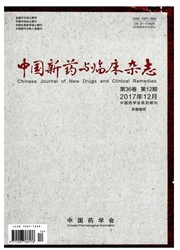

 中文摘要:
中文摘要:
目的研究伴疼痛症状抑郁障碍患者的临床特征及疼痛症状对抑郁障碍急性期疗效的影响。方法纳入符合DSM-IV诊断标准的抑郁障碍患者813例,其中有疼痛症状者439例,无疼痛症状者374例。比较两组间临床特征以及进行干预治疗患者的急性期疗效,对影响疼痛症状及急性期疗效的相关症状群进行相关回归分析。结果基线期有疼痛症状组17项汉密尔顿抑郁量表(HAMD-17)评分、HAMD—17焦虑/躯体化因子分、汉密尔顿焦虑量表(HAMA)评分、抑郁症状快速检查-自我报告评分16项(QIDS.SR16)评分显著高于无疼痛症状组[(21.87±4.80)VS.(20.33±4.43)、(7.47±2.46)VS.(6.41±2.30)、(19.18±6.18)VS.(15.12±5.37)、(20.04±5.84)VS.(18.08±6.17),均P〈0.05],且与抑郁和躯体症状量表(DSSS)疼痛症状因子分呈正相关(r=0.318、0.318、0.489、0.280,P〈0.05);有疼痛症状组6项生活质量问卷总分显著低于无疼痛症状组[(14.62±2.97)VS.(16.14±2.44),P〈0.05],且与DSSS疼痛症状因子分呈负相关(r=-0.256,P〈0.05)。有337例抑郁障碍患者同意进入药物干预治疗并完成8周随访,其中有疼痛症状组189例,无疼痛症状组148例;有疼痛症状组治愈率显著低于无疼痛症状组(X2=7.842,P=0.005);生活质量(OR=0.848,P=0.005)、焦虑/躯体症状(OR=0.864,P=0.019)、疼痛症状(OR=2.089,P=0.012)是不良治疗结局的预测因素。结论伴疼痛症状的抑郁障碍患者抑郁和焦虑症状更为显著,生活质量更差,与疼痛症状的严重程度相关。伴疼痛症状的抑郁障碍患者急性期疗效较差,且疼痛症状是急性期疗效的危险因素。
 英文摘要:
英文摘要:
AIM To explore the clinical characteristics of major depressive disorders (MDD) patients with pain symptoms and the influence of pain symptom on therapeutic effect of acute phrase of MDD. METHODS Totally 813 MDD patients were enrolled according to DSM-IV, 439 patients with pain symptoms and 374 patients without pain symptoms, and the clinical characteristics and therapeutic effects of patients treated with drug intervention were compared. The correlation and regression analysis were used to assess the syndrome influencing on the pain symptoms and therapeutic effect. RESULTS At baseline, the scores of 17- item Hamilton Rating Scale for Depression (HAMD-17) and its anxious somatic factors, Hamilton Rating Scale for Anxiety (HAMA) , and Quick Inventory of Depressive Symptomatology-the Patient Self-Report Version (QIDS- SR16) in patients with pain symptom were significantly higher than those in patients without pain symptoms ((21.87 ± 4.80) vs. (20.33 ± 4.43), (7.47 ±2.46) vs. (6.41±2.30), (19.18±6.18) vs. (15.12 ±5.37), (20.04 ± 5.84) vs. (18.08± 6.17), all P 〈 0.05), and positively correlated with pain symptoms scores in Depression and Somatic Symptoms Scale (DSSS) (r = 0.318, 0.318, 0.489, 0.280; P〈 0.05). The 6-item Life Quality Rating Scale scores in patients with pain symptoms were lower than those in patients without pain symptoms ( ( 14.62± 2.97) vs. ( 16.14 ±2.44) , P 〈 0.05) , and negatively correlated with pain symptoms scores in DSSS (r = -0.256, P 〈 0.05). Totally 337 MDD patients agreed to enter the drug intervention and completed the 8 weeks follow-up, including 189 cases with pain symptoms and 148 cases without pain symptoms. The therapeutic effects in patients with pain symptoms were lower than that in patients without pain symptoms (X2 = 7.842, P =0.005). The quality of life (OR = 0.848, P = 0.005), anxious somatic (OR = 0.864, P = 0.019) and pain symptoms (OR = 2.089, P = 0.012) were predic
 同期刊论文项目
同期刊论文项目
 同项目期刊论文
同项目期刊论文
 A study of N-methyl-D-aspartate receptor gene (GRIN2B) variants as predictors of treatment-resistant
A study of N-methyl-D-aspartate receptor gene (GRIN2B) variants as predictors of treatment-resistant Guidelines concordance of maintenance treatment in euthymic patients with bipolar disorder: Data fro
Guidelines concordance of maintenance treatment in euthymic patients with bipolar disorder: Data fro Difference in remission in a Chinese population with anxious versus nonanxious treatment-resistant d
Difference in remission in a Chinese population with anxious versus nonanxious treatment-resistant d Association between brain-derived neurotrophic factor genetic polymorphism Val66Met and susceptibili
Association between brain-derived neurotrophic factor genetic polymorphism Val66Met and susceptibili Atypical features and treatment choices in bipolar disorders: a result of the National Bipolar Mania
Atypical features and treatment choices in bipolar disorders: a result of the National Bipolar Mania Validation of the Chinese Version of the Short TEMPS-A and its application in patients with mood dis
Validation of the Chinese Version of the Short TEMPS-A and its application in patients with mood dis IL-23 and TGF-beta1 levels as potential predictive biomarkers in treatment of bipolar I disorder wit
IL-23 and TGF-beta1 levels as potential predictive biomarkers in treatment of bipolar I disorder wit 期刊信息
期刊信息
